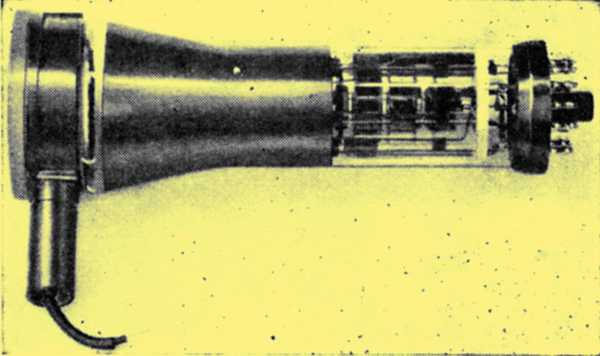|
Ultrasonic energy is being used not only for echo-sounding exploration of the heart and brain but for producing scanned images of the density distribution of internal organs and for therapeutic destruction of spurious bodies like gall-stones.
The principle of the ultrasonic telescope, as an alternative to radiography for obtaining images of internal structures, was outlined by C N Smyth last year. This year the development of a similar ultrasonic image converter was described by W Freitag, I Martin and G Schell-bach (Germany).

Ultrasonic image converter tube. The structure at the face end (left) contains the electrostatic screen surrounding the collector electrode.
The device is basically an iconoscope television-camera pick-up tube, with a quartz plate sensitive to ultrasonic energy instead of a photo-electric plate sensitive to light energy. Ultrasonic waves falling on the quartz plate in a particular intensity distribution produce a corresponding pattern of piezo-electric potentials on the plate. These potentials modulate a flow of secondary electrons from the plate to a collector electrode, the flow being produced by bombardment by primary electrons from an electron gun scanning the plate in conventional television fashion. The collector (which is screened from the direct influence of the piezo-electric potentials) then gives a signal which is used to modulate the brightness of a synchronized CRT. monitor, thus giving a television-type picture of the ultrasonic energy distribution.
Ultrasonic 'lithotresis' is the name given by one group of workers to the use of ultrasonic energy for disrupting stones in the biliary and urinary tract. Early attempts at beaming the energy from a source outside the body were unsuccessful because of the power required and the susceptibility of the intervening body tissues to damage. H Lamport and co-authors described a method by which the ultrasonic energy is conducted directly to the stone by a solid transmission line and drill tip through a catheter (a thin flexible tubular device used for passing along narrow tracts in the body). This transmission line consists of flat ribbons of Monel metal which are flexible in one direction so that they can follow the bends of the catheter. The length of the line has to be precisely related to the wavelength in order to obtain maximum transfer of energy from the magneto-striction generator, which operates at 20kHz.
|